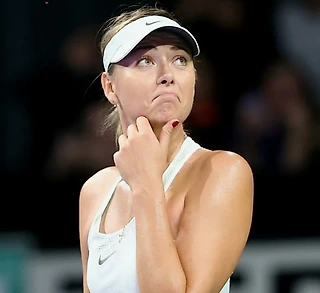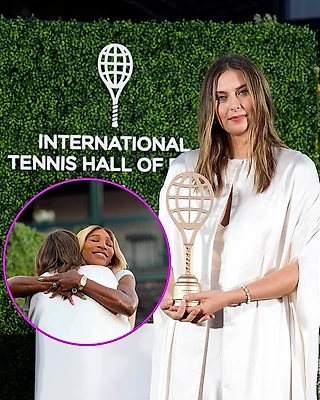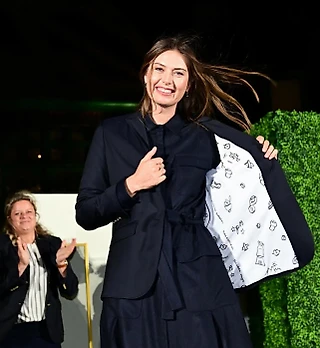The return of Maria Sharapova
Maria Sharapova was one of the biggest stars in tennis – until she was suspended from the game for failing a drug test. Fifteen months on, she’s making her comeback. Not everybody is happy about it. The sport’s most controversial player talks to Richard Evans
Maria Sharapova, 29, photographed in Los Angeles, March 2017 BJORN IOOSS
The Times, April 15 2017, 12:01am
On one of those cloudless Californian mornings of legend, the courts at the Manhattan Country Club, Los Angeles, are full of women hitting tennis balls with, shall we say, varying degrees of skill. Yet, up in the corner of the complex, on Court 18, there is a different sound. The rhythmical thwack of a ball coming off the strings at speeds of more than 70mph, time after time. It is a different kind of tennis.
A new hitting partner, the American touring pro Alex Kuznetsov, is the one soaking up the pressure as Maria Sharapova goes through the gears, moving steadily towards the level required for her planned return to the WTA Tour in 11 days’ time following a 15-month ban for failing a drug test. The Porsche Grand Prix in Stuttgart has given her a wild card (with all her ranking points gone, it is her only way into the draw) and a media circus can be expected. Indeed, she cannot even enter the arena until April 26, two days after the event starts, because that is when her ban actually ends. The 29-year-old has also been given a wild card for the Mutua Madrid Open and the Rome Masters. (There will be no decision until May as to whether she can compete at Wimbledon – assuming, that is, she hasn’t accumulated enough ranking points by then to guarantee her place.)
To put it mildly, her return to professional tennis will divide opinion. There are those who think her stature as a five-time Grand Slam champion is a good enough excuse for tournament organisers, thirsting for the publicity, to offer her a pass into the draw, especially as the Court of Arbitration for Sport has decreed that she should not be described as a “doper” – her offence being an administrative fault rather than an attempt to gain unfair advantage.
On the other hand, Andy Murray is one of several players who has queried whether a player banned for any type of drug offence should be given a helping hand. “I think you should really have to work your way back,” he told The Times last month. Most of the objections, though, are emanating from the women’s locker room, where Sharapova has never been a popular figure. Former world No 1 Caroline Wozniacki and the French player Kristina Mladenovic have been most vocal in saying that she does not deserve special treatment. Wozniacki said that her wild card for Stuttgart is “disrespectful”. Sharapova does, however, have her supporters. Venus Williams has said she should be welcomed back.
One can understand why other players do not warm to her. With her game face on, peering down at fellow players from a height of 6ft 2in, Sharapova does not present herself as very approachable. She knows that and, frankly, she doesn’t care.
We meet the evening before this practice session in the restaurant of the country club. She is dressed in loose-fitting, flannel tracksuit bottoms and a pink T-shirt, her forehead still moist after a session on the treadmill. “Here, this seems appropriate,” she says with a smile as we settle on a table overlooking the courts. When I go straight to the topic of her strained relationship with many of her peers, she replies, “I treat the tournament as my office. That’s where I do my work. It’s where I am totally committed. My goal is to be professional. To get through my training; to be on time; to be ready to play on Centre Court or Court 18; to play my match and do my press conference. That’s it. When I get to the locker room, I’m not sitting there sipping tea and eating macaroons.”
Does the criticism in the media and from her fellow players bother her? “What people think is out of my control,” she replies with a hint of resignation. “There’s only so much I can do on that score.”
On her way to winning Wimbledon in 2004
GETTY IMAGES
Later, her coach, the Dutchman Sven Groeneveld, emphasises Sharapova’s ability to focus and live in a bubble. “When we get in the car on match day, there is a complete switch in her personality,” Groeneveld says. “The expression changes. Mobile phones are switched off. She has the ability to compartmentalise her life like no one I have ever known.”
Groeneveld, one of the world’s most experienced coaches, has watched numerous champions in close-up. He has coached Monica Seles, Ana Ivanovic and Mary Pierce, as well as Sharapova, to Grand Slam titles.
Even the screeching accompanying her shots, which has reached 101 decibels, is simply part of the package, he says. “I started with Monica, who was just as loud. Frankly, I don’t hear it, but I know it bothers people. It is too late to change now.”
I remember meeting Sharapova when she was 14, escorted into the press room to say hello at the Australian Open by her agent, Max Eisenbud, who went on to help the wide-eyed waif earn more than £20 million a year.
But this is our first adult conversation and, having listened to her in so many post-match press conferences, I am not surprised to find myself facing a woman who is warm and open and ready to see the funny side of life. Even when she was going through the excruciatingly awkward press conference to announce her positive drug test in March 2016 – a conference many had thought was to announce her retirement – she still cracked a joke. “I know many of you thought that I would be retiring today,” she said, “but if I was ever going to announce my retirement, it would probably not be in a downtown Los Angeles hotel with this fairly ugly carpet.”
But a joke could not deflect from the cataclysmic effect that the drug revelation would have on this extraordinary athlete, who burst onto the world stage in 2004 when she won Wimbledon at the age of 17. Within a few years she had established herself as one of the most successful players of her generation, winning the US Open in 2006 and the Australian Open two years later.
Most critics felt that would be the limit of her Grand Slam-winning capabilities because Sharapova, ever willing to take a dig at herself, had described her efforts to move on clay as resembling a “cow on ice”. Typically, however, she persevered and, after Groeneveld’s predecessor, the Swedish coach Thomas Hogstedt, had worked to strengthen her legs and improve her movement, she surprised everyone by winning the Italian Open in Rome on clay in 2011. A year later she did it again, and promptly followed it up by exceeding her wildest dreams in Paris where she defeated Italy’s Sara Errani to become French Open champion. The victory meant she joined her nemesis, Serena Williams, as the only player since Steffi Graf to win all four Grand Slams – something Venus Williams, Monica Seles and Justine Henin have all failed to do.
When she repeated her success in Paris in 2014, her prowess on all surfaces, built on power and the unrelenting fierceness of her competitive spirit, entitled her to be regarded as one of the great players of the modern era.
With coach Sven Groeneveld in 2015
GETTY IMAGES
None of this would have happened had her father, Yuri Sharapov, not taken the daring decision to leave his wife behind in Russia and take his seven-year-old daughter to Florida. Yuri worked on building sites to survive, while little Maria impressed Nick Bollettieri’s coaches at his Academy in Bradenton, Florida, sufficiently for sports management company IMG and sports brand Nike to offer the first trickle of money that would eventually grow into million-dollar contracts.
So how did it all come crashing down? Sharapova traces it back to a visit to the doctor in Moscow just after she won Wimbledon in 2004.
“I was becoming constantly fatigued,” she says. “I was getting colds and flu and it started to affect my body. So I was taken to a doctor in Moscow my father knew. My heart showed an abnormality. So he gave me about ten supplements to take, one of which was Mildronate. I was told to take them before excessive exercise.”
In 2015, Wada (the World Anti-Doping Agency) decided to start monitoring a supplement that was publicly referred to as meldonium – which is sold under the brand name Mildronate – when it was found that scores of athletes from Russia and other eastern European countries were taking it.
At the end of the year, it was decided to put it on the banned list as of January 1, 2016. Wada publicised this important fact with a densely worded email that Sharapova admits she did not read. More importantly, nor did she ensure that her team had read it. However, there were a claimed three further communications from the International Tennis Federation (ITF) and two from the Women’s Tennis Association (WTA) in December 2015 containing warnings that meldonium was to be banned. Surely she must have known that meldonium was supposed to have performance-enhancing ingredients?
“I didn’t even know what meldonium was,” Sharapova insists. “I had to google it to find out. To me, it was Mildronate.”
To her credit, she didn’t parcel out blame. No one got fired. And throughout this ban, all the principal members of her team have stayed with her. Groeneveld, whose reputation could instantly have secured him another job, says he didn’t consider leaving her employ.
“When she called me to read the email from the ITF telling her of the positive test, she was obviously in shock,” he says. “I had been with her for two years and it was the last thing I could imagine happening to Maria.”
Sharapova is critical of the way the ITF handled the banning of meldonium. The authorities, she says, knew she was taking it when she played on the Russian team in the Fed Cup in Prague in November 2015.
“It was an ITF event,” she says, “so why didn’t someone come up to me and have a private conversation, just an official to an athlete, which would have taken care of the confidentiality problem they talked about later? But nothing was said by anyone.”
Sharapova feels that her advisers could have done better. “But ultimately the fault was mine. I had been getting clearance on everything I was taking for seven years and I became complacent. I got too comfortable. But then so did the ITF.”
The original decision was a two-year ban, and she has said she believes the ITF was keen on getting the maximum ban of four years, which would have ended the career of one of only two real female superstars currently selling tickets on the WTA tour (Serena Williams being the other).
With the exception of Tag Heuer, all her major sponsors – including Nike, Evian and Porsche – are, after suspending their contracts on news of the ban, sticking with her. She didn’t hide away during her suspension. In May last year Sharapova attended the Met Gala in New York. That same month she launched a new line of chocolate as part of her Sugarpova sweets brand at the Sweets & Snacks Expo in Chicago. She released an advert for her Head racket bag during the US Open in September and then hit New York Fashion Week. She kept her hand in playing for the World Team Smash Hits event in Las Vegas in October, where she appeared in a selfie with Sir Elton John. In January this year she announced her comeback in Stuttgart, and 2017 has also thus far included a photoshoot with Annie Leibovitz and Sharapova’s attendance at the Vanity Fair Oscar Party.
It has been suggested that she really should have been more publicly contrite. But that is to ignore why Sharapova is such hot property for her sponsors. She is one of the greatest competitors in world sport this century. I will never forget commentating on her match against Alexandra Panova at the Australian Open two years ago, when temperatures got stuck at around 38C and she had to dig herself out of two match points against her lowly ranked compatriot.
I ask her what was pushing her to do this. The heat was unbearable and she was killing herself out there on Rod Laver Arena. Does someone who earns £20 million a year really need this kind of torture?
During her suspension, she launched a new Sugarpova brand in May 2016...
GETTY IMAGES
...and enrolled at Harvard Business School in June 2016...
MARIASHARAPOVA/INSTAGRAM
...and networked at the Oscars in February 2017
GETTY IMAGES
She laughs at the memory. “It was hot! But my fighting qualities come from realising at a very young age what amazing opportunities I had been given and how lucky I was to be doing what I was doing; having a company like Nike help me travel to tournaments knowing that there were other kids in the world who were not so fortunate. So I worked my ass off.
“I saw how hard it was for my mother to get a visa to visit us. I saw how hard it was for my father to find work. I saw how everyone had to work hard whether it was for $1 or $1 million. So my competitiveness comes from developing a work ethic.”
Sharapova required shoulder surgery on a rotator cuff in 2008, which, she says, put things in perspective. “It just taught me that you never know. I didn’t know if I would ever play tennis again, so I looked for something that would challenge me and keep my mind busy.”
The result is Sugarpova, the sweet company she runs. “I got the idea from the first time I went to the movies in America as a child and saw all those buckets of gummies you could just scoop up,” she says. “I had never seen anything like it. I wanted to package them as souvenirs and, with the help of Jeff Rubin, an industry expert, we’re expanding into chocolate. I’m still learning, but I love being in charge of something I can control instead of just being a vehicle for a big company.”
Part of the proceeds from Sugarpova go to her charity, the Maria Sharapova Foundation, which supports victims of the Chernobyl nuclear disaster. Sharapova’s mother, Yelena, was pregnant with Maria when the accident happened and her family fled to Siberia to avoid any possible damage being done to a child born in the contaminated area. Her grandmother still lives in Gomel, 70 miles north of Chernobyl, and her charity funds five-year art and academic scholarships for a dozen local students every year.
Sharapova in 2007, with children from Chernobyl who are supported by her charity
REUTERS
That is the serious Sharapova. The fun side is less obvious to people who do not get inside her social circle. But she does know how to enjoy herself. Much of the time she spends with her team, at her house a couple of blocks from the ocean in LA’s Manhattan Beach, either cooking with her mother – they make borscht and stuffed cabbage – or enjoying the efforts of her French fitness trainer, Jérôme Bianchi, whose tarte aux pommes she adores.
“But I have been dating a lot,” she says with a peel of laughter. “I have had a great dating life in the past 12 months. No, I don’t have a boyfriend, if that’s what you’re asking, but I have enjoyed going out with different people from different cultures in different professions. And they’re not all American. From that perspective, I’m all over the map.”
I saw her all glammed up one night in her high heels, standing about 6ft 5in, heading out for some red-carpet function, and wondered what sort of guy would be able to handle the Sharapova package. I suggest to her that she must see at least three types: the man who is completely intimidated and too shy to come forward; the bombastic chancer, hiding his nerves behind silly jokes; then the man, totally comfortable with himself, who would treat her as a normal person.
“Really? You have found that guy?” She laughs. “Let me know! I’m still looking.”
They are obviously a rare breed, but Sharapova knows what she is looking for. “Someone with their own personality, own opinions and their own life who is obviously comfortable in their own skin. That’s very attractive. Someone who is confident but in an internal way.
“I gravitate towards people who tell you like it is,” she continues. “People who appreciate the good in you, but are able to tell you when something isn’t. I don’t want sugar coating. I want constructive criticism. I think that is so important in friends.”
Her last serious relationship was with fellow tennis player Grigor Dimitrov, the handsome, outgoing Bulgarian, currently ranked No 12, who was just starting to make his way on the ATP tour when they met. They broke up a couple of years ago, but still talk. “We have a strong bond. We cared a lot for each other and still do.”
I ask her about her self-image. After a brief pause, she replies, “I’ve never considered myself to be beautiful. That’s not the way I function. I don’t look at myself in the mirror and say, ‘There’s a beautiful woman.’
“My mother taught me there are a lot of aspects of a person that are more beautiful than external beauty.”
She calls herself “a very simple girl”, which, of course, is not quite the image she presents on court or in those heels at a Vanity Fair party. But, again, she can compartmentalise.
“I try to be authentic. I never try to be someone I’m not. I never try to dress as someone I’m not. If I never had to wear make-up again in my life, it would be fine.
“I can be just as comfortable in a private plane as I can flying commercial in the back row with my girlfriend because she can’t afford to fly in first. When you start off in the back row of Aeroflot next to the toilet, you know where you come from. I never forget.”
Shoot credits
Hair Adir Abergel, creative director of Virtue Labs at Starworks Artists
Make-up Kara Yoshimoto Bua at Starworks Artists using Christoffe
Clothes Nike
https://www.thetimes.co.uk/magazine/the-times-magazine/the-return-of-maria-sharapova-2sxmjqmtz
>










Продали столь много книг, что сайт B&N даже прекратил продажу, не было больше книг Марии для продажи!
:):):)
:):):)
"When I get to the locker room, I’m not sitting there sipping tea and eating macaroons.”
When she repeated her success in Paris in 2014, her prowess on all surfaces, built on power and the unrelenting fierceness of her competitive spirit, entitled her to be regarded as one of the great players of the modern era.